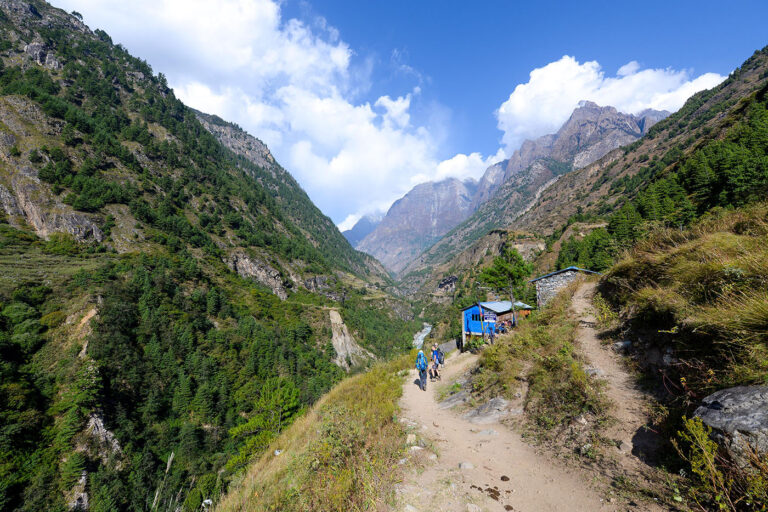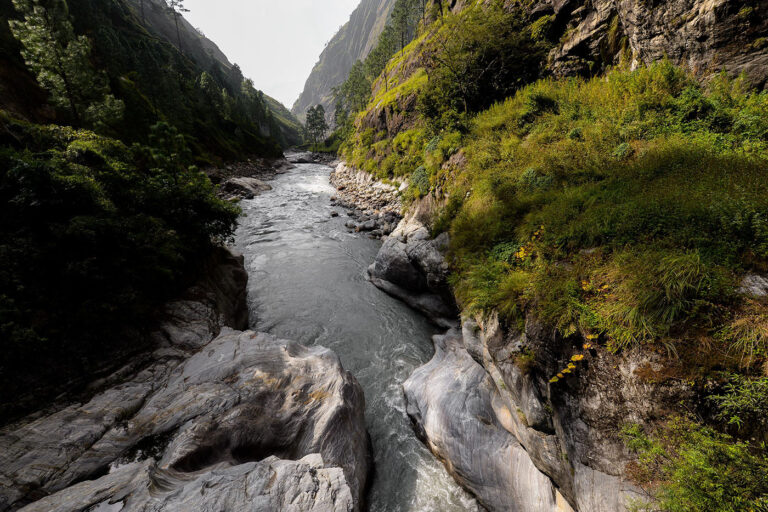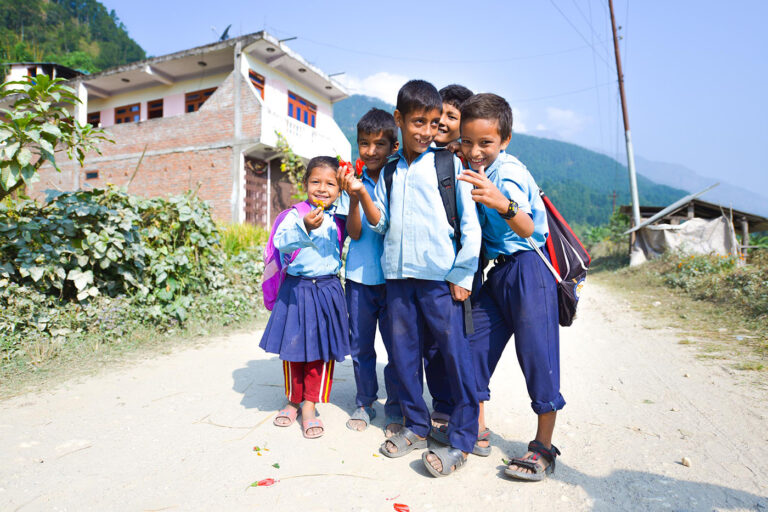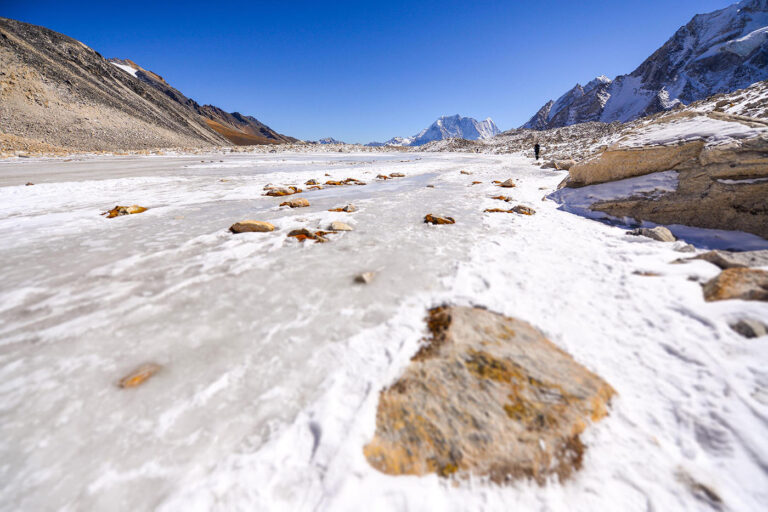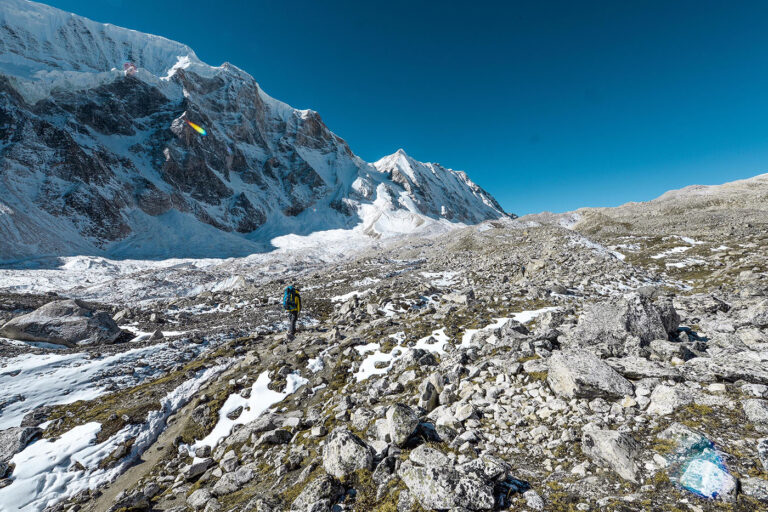Day 01 – Drive to Arughat bazaar (608m) – 8 hours drive – There are two routes to get to Arughat bazaar from Kathmandu, via Gorkha bazaar or via Dhadingbesi, but both routes may take about 8 hours and offer similar views of rivers, green forest, terraced fields and many small villages.
Day 02 – Trek to Lapubesi (884m) – 7 hours walk – Trek start on the flat trail pass by many small villages called Arkhet, Sotikhola and Khorsane where dozen of tea houses offer rooms and serve meals to trekkers. The trek from Arughat to Khorsane village is mostly flat and takes about 3.5 hours. From Khorsane the trail is mostly rocky.
Day 03 – Trek to Tatopani (990m) – 6 hours walk – Trek begins on a mix of flat and rocky path following Budhi Gandaki river. The temperature can be a little warm, but still most of the time, trekkers walk in the shade with the view of beautiful waterfalls, green hills, verdant paddy fields and suspension bridges over the Budhi Gandaki. After Lapubesi we will pass the villages of Khanibesi, Machhakhola, Khorlabesi and then reach Tatopani village where guest houses are available.
Day 04 – Trek to Jagat (1340m) – 6 hours walk – Trek from Tatopani to Jagat will be little bit harder than previous days as our ascent will become more strenuous. Our ascent will take us past Dobhan, Thulodhunga and Yaruphat villages. We will get to enjoy views of impressive cliff sides, Budhi Gandaki gorge and amazing waterfalls. The village of Jagat is a bit larger than previous villages and is divided into two parts (lower and upper Jagat). Upper Jagat offers best lodging and scenery.
Day 05 – Trek to Dyang (1860m) – 7 hours walk – We begin the morning by trekking along the Budhi Gandaki gorge passing Salleri, Sirdibass and Philim villages which are settlements of the Gurung people. Here you may see hundreds of sheep and goats grazing on the hills as well as water mils traditionally used to grind wheat, buckwheat and maize. There is an ancient monastery above Philim called Chyoling Samdu Gompa which offers stunning views of Shiringi Himal. After Philim we will pass Klebhatti, Nyak, Pewa villages and finally reach Dyang.
Day 06 – Trek to Namrung (2630m) – 7 hours walk – Trek starts flat until we reach the village of Rana (around 30 minutes). From here we will follow the rise and fall of the trail along the river path until we reach Bhiphedi village. From there, the trail becomes more gradual until Ghap. The trail from Ghap to Namrung takes approximately 4 hours and is mostly uphill passing through dense forest with views of huge rocky hills, mani walls and monasteries.
Day 07 – Trek to Lho (3180m) – 6 hours walk – Today will be one of the most memorable days of this trip. We will pass many ancient villages which are steeped in Buddhist culture. We will pass by Lhi and Sho villages which offer beautiful views of Simnang Himal, Baudha Himal and Himalchuli peaks. Lho village sits on a beautiful Himalayan plateau where trekkers can explore the Ribung Gompa. From the Ribung monastery trekkers can see massif views of mount Manaslu (8163m), the 8th tallest mountain in the world.
Day 08 – Trek to Samagoun (3520m) – 5 hours walk – The trek from Lho to Samagoun is yet another fine and joyful day due to panoramic views of Naike, Nadi Chuli, Himalchuli and mount Manaslu peaks. Shyala and Samagoun are rich with religious sites (monasteries and stupas). Points of interest around Samagoun are Birendra Tal (Birendra Lake), a small monastery to the north and a large mani wall in the center of the village (probably the largest mani wall in the Manaslu region).
Day 09 – [Potential] Acclimatization day (side trip to Phungen monastery) – 5 hours walk – It is HIGHLY recommended for a trekker to do at least one day of acclimatization before Larke pass (either at Samagoun or Samdo). There are many side trips around Samagoun such as Manaslu base camp, Birendra lake and Phungen monastery. Among them a trip to Phungen monastery is most popular. Phungen monastery is believed to be more than 600 years old and is surrounded by Manaslu, Nadichuli and Himalchuli peaks and views of glaciers and glacial lakes.
Day 10 – Trek to Samdo (3875m) – 4 hours walk – Today we will approach Samdo on a gradual ascent with stunning views of surrounding peaks. This will be a relatively easy walk due to flat and gradual climb. Samdo is a beautiful Himalayan village where lodges are welcoming trekkers with delicious meals and warm hospitality.
Day 11 – [Potential] Acclimatization day – There are many spots to do acclimatization around Samdo village but to choose Samdo Danda would be the best option as you will see beautiful views of Samdo Himal, Naike ,Larke Himal, Manaslu, Nadi Chuli, Himalchuli peaks and some peaks from Tibetan side. A side trip to Samdo Danda takes about 4 hours roundtrip.
Day 12 – Trek to Dharmasala (4460m) – 4 hours walk – Dharmashala provides the last lodging opportunity before the Larke La pass. The tea houses are very basic providing trekkers four walls and a bed. 30 minutes after Samdo you will reach a small stream and flat ground called Larke Bazaar which according to the locals it was a trade center between Tibetan people and locals in the ancient time. You will continue the a gradual ascent for 3 hours towards Dharmashala.
Day 13 – Trek over the Larke La pass (5106m) and down to Bhimthang (3720m) – The trail from Dharmashala to the top of the Larke-La pass is mostly gradual up but trekkers may feel the lack of oxygen and cold therefore moving slower than usual. The trek starts early in the morning to ensure enough time to pass before the afternoon wind over the pass. As we are moving up step by step slowly towards the pass, we will see views of Larke Himal, Kangaroo Himal, Himlung Himal, Kechhakyu Himal, Pari Himal and huge glaciers and glacial lake (Ponkar lake). After Larke La pass trekkers walk down about 4 hours to get Bhimthang village to rest and recharge.
Day 14 – Trek to Gho village (2515m) – 5 hours walk – From Bhimthang village the trail descends rapidly towards the valley while offering a view of North Manaslu. You will walk through dense pine and Rhododendron forests. We will grab lunch in one of the small villages along the trail and continue our descent towards Gho.
Day 15 – Trek to Tal (1700m) – 7 hours walk – Trekkers will head down towards Tal which is a beautiful hamlet on the main trekking trail of Annapurna circuit. The trail passes Tilche, Thoche, Dharapani, Khotro and Sirantall villages which are settlements of the Gurung people. Trekkers will experience the real hospitality of Gurung people in one of many guest houses in Tal with delicious meals and drinks.
*From Dharapani to BesiSahar, the road has been developed which overlaps with the trail at certain points. There are some alternative trails but sometimes we will walk on the road. There is an option of taking a jeep from Dharapani to BesiSahar.
Day 16 – Trek to Ghermuphat (110m) – 5 to 6 hours walk – After 15 minutes we will come across the border of Manang and Lamjung districts. The trail then gently descends towards Sattale village passing through rocky path and bamboo forest with the views of green hills, waterfalls and Marshyandi river. We will pass by small villages called Chyamche, Jagat and Shreechaur. Major attractions of the day would be the amazing waterfalls and wild bee hives which can be seen near Chyamche village.
Day 17 – Trek to Bhulbhule (840m) – 6 hours walk – Trekkers will walk through the terraced paddy fields with views of villages which are dramatically settled on the vertical land. The trek from Ghermuphat to Bahundanda will be pleasantly flat and takes about two hours. We will then descend towards Bhulbhule passing by Ngadi. There are many guest houses in Bhulbhule waiting for you.
Day 18 – Drive back to Kathmandu – 7 hours drive – Trekkers can take a bus or jeep from Bhulbhule. You will enjoy the views of the river, green hills and charming landscape on your drive back. if trekkers have enough time they can walk to Besisahar taking an alternative

